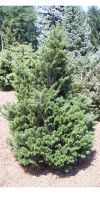Products description
Photinia is a genus of about 40-60 species of small trees and large shrubs in the Rosaceae. As interpreted here, they are restricted to warm temperate Asia, from the Himalaya east to Japan and south to India and Thailand, but some botanists also include the closely related North American species Heteromeles arbutifolia in Photinia as Photinia arbutifolia.
Some species, notably P. davidiana, are sometimes split off into a separate genus Stranvaesia, and others, into another separate genus Pourthiaea. The genus Aronia is included in Photinia in some classifications. Other close relatives include the firethorns (Pyracantha), cotoneasters (Cotoneaster) and hawthorns (Crataegus).
The scientific name Photinia is widely used as the common name; another name sometimes used is "Christmas berry". Photinias typically grow from 3-15 m tall, with a usually irregular crown of angular branches; the branches are often (not always) thorny. The leaves are alternate, entire or finely toothed, varying between species from 3-15 cm in length and 1.5-5 cm wide; the majority of species are evergreen but several are deciduous.
The flowers are produced in early summer in dense terminal corymbs; each flower is 5-10 mm diameter, with five rounded white petals; they have a mild, hawthorn-like scent. The fruit is a small pome, 4-12 mm across, bright red and berry-like, produced large quantities, maturing in the fall and often persisting well into the winter. The fruit are consumed by birds, including thrushes, waxwings and starlings; the seeds are dispersed in their droppings.
Photinia species are sometimes used as food plants by the larvae of some Lepidoptera species including Common Emerald, Feathered Thorn and Setaceous Hebrew Character. shrub
height: from 60 cm to 80 cm
baled or in container (extra charge for container)
photo: Model plant High-level trunk









